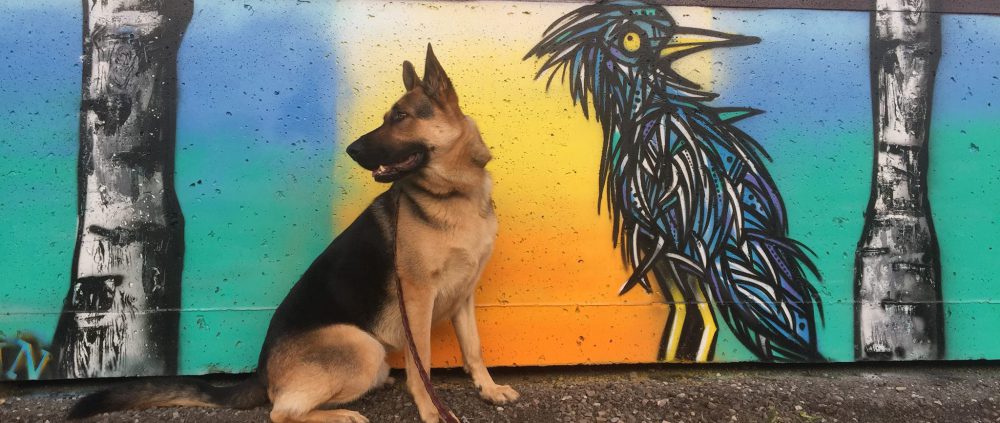 The frustration I feel when I see people look at abstract art and say, “I could do that,” is tinged with hypocrisy. Why? Because when I look at paintings like Blue Column, by Morris Louis, I say it too.
The frustration I feel when I see people look at abstract art and say, “I could do that,” is tinged with hypocrisy. Why? Because when I look at paintings like Blue Column, by Morris Louis, I say it too.
I say it even though I know that Blue Column is art and is important. Afterall, even though I could have produced that painting, I didn’t. And, I love color field paintings and can gaze at them for hours.
I have to remind myself that just because the bar might seem to be set very low when we call an abstract painting “art,” it doesn’t mean that the picture is unimportant or banal.
This attitude toward art helps me be more fairminded and respectful of science. Particularly of scientific research that seems to set the bar really low for canine emotion, consciousness, and cognition.
There is lots of scientific research that seems to do this. And my initial response to that research is generally pretty snarky.
For example, Juliane Bräuer et al just published a research study titled, “A ball is not a Kong: Odor representation and search behavior in domestic dogs (Canis familiaris) of different education” in the Journal of Comparative Psychology. The paper reported that when working and companion dogs followed a scent trail produced with one toy and encountered a different toy at the end of that trail, they hesitated.
My initial disrespectful response to the paper was, “No shit Sherlock, I could have told you that.”
But that response inhibits my curiosity about the research program that produced the paper and undermines my ability to think about why the researchers did that experiment and how they might have done it better.
This experiment was designed to explore whether dogs have a mental representation, a sort of olfactory picture in their minds, of objects in their world. The researchers are interested in canine consciousness, just like me.
The researchers found that pet dogs and working dogs, some of whom were trained in search and rescue, both hesitated the first time they encountered the wrong toy at the end of a scent trail, but didn’t hesitate in subsequent trials. They also found that the working dogs followed the trail faster than the pet dogs, but again, only in the early runs of the experiment.
This experiment brings some interesting things to mind:
- Most scientific tests of animal consciousness rely on vision. Since dogs are primarily sniffers rather than lookers, it isn’t surprising that they do poorly on these tests. By focusing on olfaction rather than vision, this experiment is at least starting to consider canine minds from a dog’s point of view.
- The similarities researchers found between pet and working dogs are striking. Even though the working dogs had formal training and regular practice, they didn’t significantly outperform the pets. This experiment seems to be latching onto something that arises spontaneously in dogs.
I’m still bothered because the researchers set the bar so low for determining whether a dog has a mental representation of what she’s smelling. From my perspective, there was no need to do this experiment because the results are obvious:
- If we think of this from an ecological or evolutionary perspective, it’s difficult to imagine a creature who uses scent to hunt for prey not hesitating when they find a surprising item at the end of a track.
- I do tracking with my German Shepherd, Milo. When he comes to the end of a track, which is what happened in this experiment, he hesitates and sniffs around trying to find it again. That is what dogs do, and it is what the dogs in this study did. It seems that if the researchers had collaborated with an expert dog handler, they’d have seen that this was an unnecessary experiment.
But, I sometimes forget that my perspective isn’t the only one out there. What if the researchers weren’t trying to prove this point to someone like me?
Afterall, 25 working dogs took part in this study and presumably those dogs’ handlers knew what was going on and I bet the results weren’t surprising to many of those people either.
These researchers were speaking to a scientific community in which many members are skeptical that creatures other than humans and chimpanzees have rich inner lives. (I have one friend who describes rabbits as furry machines that turn carrots into poop.) When juxtaposed against background beliefs like these, this study’s results become surprising, interesting, and important.
Also, this study might be a necessary building block for more complicated investigations of canine consciousness and representation.
Finally, some people will give scientific knowledge more authority than the experience of expert dog handlers and trainers. For example, a scientific paper might convince policymakers who would not be moved by expert testimony that we need practices and laws that respect dogs as having rich inner lives.
I didn’t need this experiment to tell me that dogs have representations of what they are smelling. But that doesn’t make the research unimportant. This experiment is much more convincing than my blustering “I could have told you that” will ever be.

Ha! Rabbits can be quite interesting to watch actually. They spend a lot of time lounging around, but also enjoy digging, running around and kicking their heels up, (which is known as a binky,) and being bitchy to each other on occasion. 😄
LikeLiked by 1 person
I know, I have other friends with companion rabbits who are lovely pets. 🙂 Not just poop machines after all!
LikeLiked by 1 person
That is, if they are not kept in small wire cages as many seem to keep them.
LikeLike